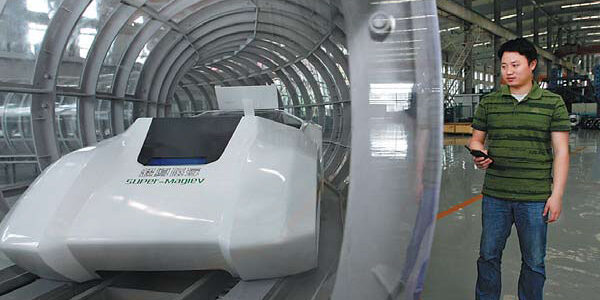Transport is changing rapidly at what seems to be on a daily basis. From the Hyperloop One, autonomous ships, self-driving cars to flying taxis and now, a high-performance maglev train. We’ve come so far in the last 5 years alone, it’s hard to imagine what will be next.
Elon Musk has already provided some insights with the Hyperloop One and now it’s time for China to shine. Let’s be honest, they’ve always been known for their impressive railway systems and outrageously fast trains. Their high-speed rail certainly remains one of the most impressive civil engineering achievements within recent times. The network of passenger trains can travel between 250 – 350 km/h (155 – 217 mph), and covers 29 provinces. That is a true indication of quality workmanship, engineering prowess and continuous forward-thinking.
Super Maglev Train Prototype Could Hit 1000 km/h
The Global Times newspaper recently confirmed that a super maglev train could soon be revealed. Initial reports suggest that the bullet train can travel at speeds of up to 1000 km/h (621 mph). That is faster than a Boeing 737 or Airbus 320 which generally cruise at about 700-800 km/h (435-500mph).
According to Professor Deng Zigang and his team from the Southwest Jiaotong University, a proof-of-concept prototype is ready for track testing. Deng further told China Central Television and other media outlets that the maglev train incorporates two unique technologies – maglev and tube transport. Maglev technology eliminates wheel-rail friction while the vacuum-tube transport technology takes care of air friction.
They’ve constructed a 45-meter long tube inside the lab after years of meticulous research. There is always method behind the madness as the contraption resembles that of a toy-train set but that’s where the similarities end. Carriages on this track can constantly levitate at a height of 20 millimeters, either in motion or static. It can also hold a payload of up to 1 ton which is a new world record in the race to develop the next-generation “levitating trains.”
The tube transport of the maglev train is similar to the technology that would be used on Elon Musk’s Hyperloop system. His Boring Company has recently received preliminary approval to build the underground Hyperloop system connecting New York and Washington DC. Traveling between these two cities at 700 mph (more than 1 000 km/h) will take less than 30 minutes covering 328 km (203 miles).
Some believe it may even extend beyond transporting people utilising cargo pods. This could lead to massive savings in time and money compared to traditional transport methods.
Maglev Train Technology Limitations
China’s last major addition to its high-speed rail system was in August 2017. It came six years after a fatal accident which resulted in China re-evaluating its rail service and capping the top speed. Even with the limitations in place, China still cemented its spot as the world leader in bullet train technology.
Although China is leading the charge in terms of research and commercialisation of maglev trains, there are still major obstacles to overcome. They should know better than most as the Shanghai maglev train has been running between the city center and Pudong Airport at 430km/h since 2002.
According to one rail expert, “The train needs to come to a complete stop in an emergency situation”. He continued by stating that braking at high speeds can be achieved in the open air using brakes and natural air resistance. However, it could be a concern within a vacuum tube where, theoretically, no resistance exists.
They need to address safety standards, excessive construction and maintenance costs before such a ‘super bullet train’ goes into service. Mechanical breakdowns or system failure were among the additional concerns, i.e. what measures are in place if the vacuum tube breaks or leaks air?
What are your views on these almost ‘supersonic trains’? Would you feel comfortable riding in an air-tight vacuum-tube at lightning speed? Please share your comments in the section below or find us on Twitter, Facebook, YouTube, Google+ or LinkedIn. Please comment on social media using our new hashtag #PRVtech.
We specialise in various industries including rail, automotive, aerospace, construction and defense. Get in touch if you have any questions about PRV Engineering or if you need assistance with your project.


Recent Comments